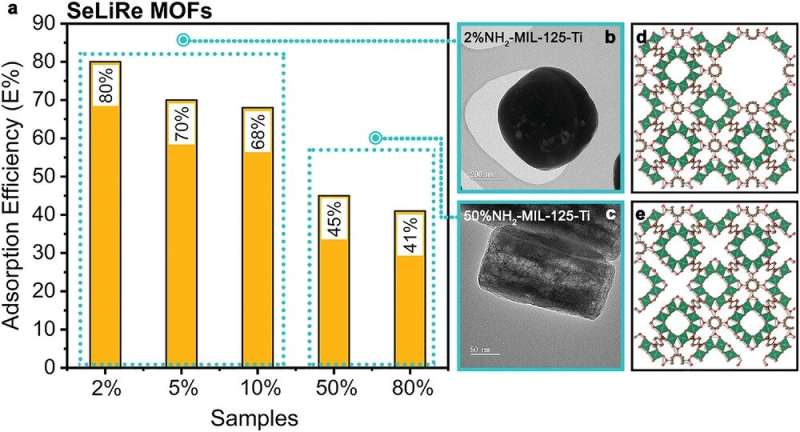a) Glyphosate initial adsorption after one hour for SeLiRe samples with different ligand ratios, demonstrating the highest adsorption efficiency for the 2%-SeLiRe MOF. b,c) BF-TEM images of individual particles of 2%-SeLiRe and 50%-SeLiRe MOFs with bright areas indicating ligand removal in the form of cavity-type pores and network fracture-type pores, respectively. d,e) Schematic representation of cavity-type and fracture-type mesopores introduced through SeLiRe. Credit: Advanced Functional Materials (2023). DOI: 10.1002/adfm.202213862
Contaminated drinking water poses a major threat to our health. However, various pollutants such as pesticides, herbicides, hormones, medicines and other chemical compounds cannot be completely removed from groundwater with the methods currently available. At the same time, contamination by these substances is steadily increasing. A current example is glyphosate, which is used worldwide for weed control and poses potential dangers to humans and the environment.
A team led by Prof. Dominik Eder (TU Wien, Institute of Materials Chemistry) has now developed a new class of materials—so-called metal-organic frameworks (MOFs)—which can be used to selectively and efficiently remove the herbicide glyphosate from groundwater. The researchers recently published their results in the scientific journal Advanced Functional Materials.
Small volume, large surface
MOFs are materials consisting of tiny metal oxide clusters connected by organic molecules to form a highly porous, sponge-like network. They have an extremely large surface area of up to 7000 m²/g. " This means that you can fit an entire football field within just one gram of MOFs," Dominik Eder says. "Consequently, a lot of molecules can adsorb within the pores, making MOFs ideal materials for directly capturing molecules from air and water, such as CO2, inorganic salts and organic pollutants."
The special thing about MOFs is that they can be customized depending on the application. Shaghayegh Naghdi, lead author of the study, explains: "Think of MOFs as a large building consisting of individual tiny blocks. Each block is made up of metal atoms or organic molecules and you put them together like a puzzle to achieve the desired functions."'
Mesopores for large molecules
However, a crucial limitation of MOFs for their use in liquid media is the accessibility of active sites deep inside the material, where the adsorption processes and chemical reactions take place. To reach these sites, the target molecules must diffuse through micropores with diameters of less than 1 nanometer, which is often the size of the molecules themselves. In liquid media, solvent molecules can significantly slow down this diffusion process and clog the pores.
To solve this problem, the research group has developed a strategy to incorporate additional pores with a diameter of up to 10 nanometers, so-called mesopores, into the MOFs. How does this work? "We selectively burn away a certain part of the organic compound molecules," Naghdi explains. "However, we need to do this very carefully, in order to avoid collapse of the overall micropore structure." The team has already tested this strategy for various applications in liquid media.
Successful removal of glyphosate
In collaboration with researchers from the University of Northern British Columbia in Canada, Dominik Eder's team finally investigated the adsorption of glyphosate from groundwater. Remarkably, the new material was able to remove three times as much glyphosate in only 20% of the time as the currently best adsorbent.
With the help of computer simulations carried out at the Technion in Israel, the group also discovered that the removal of the organic linkers creates new metal sites. These allow the formation of chemical bonds with glyphosate and thus faster diffusion of the target molecule. "These bonds are strong enough to adsorb glyphosate and similar organic compounds very quickly and efficiently. Yet, they are weak enough to remove glyphosate quantitatively with a simple sodium chloride salt solution, so that these MOFs can be used multiple times," Dominik Eder explains.
More information: Shaghayegh Naghdi et al, Glyphosate Adsorption from Water Using Hierarchically Porous Metal–Organic Frameworks, Advanced Functional Materials (2023). DOI: 10.1002/adfm.202213862
Journal information: Advanced Functional Materials
Provided by Vienna University of Technology
























